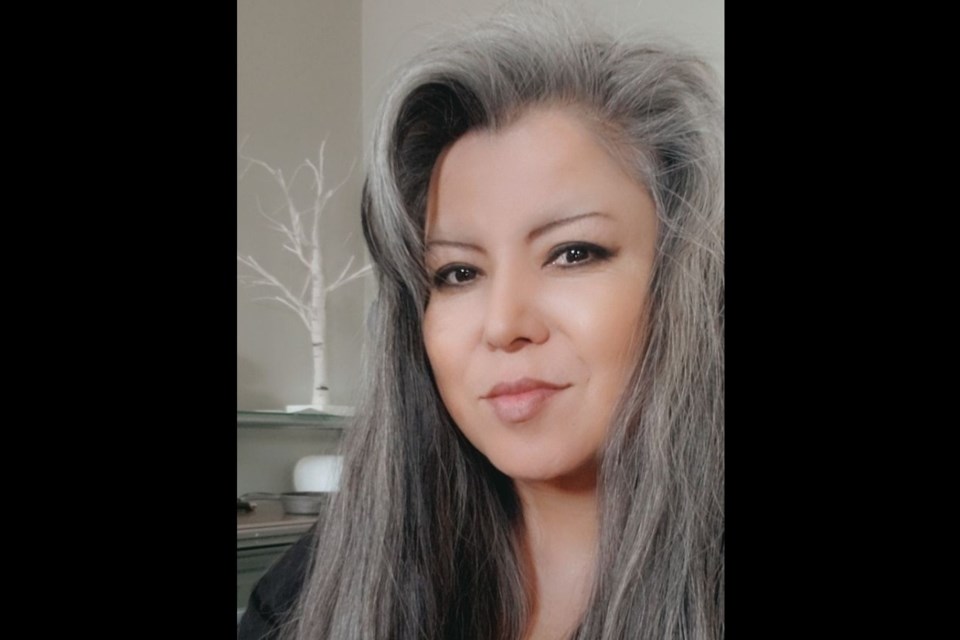Crystal Semaganis says she has a personal need to get out there and help people in any way she can.
Semaganis, 50, is a Plains Cree artist, mother of four, writer, photographer, activist and public speaker from Treaty 6, now living in Timmins.
Helping people make connections is something close to her heart.
“I see myself as a little agent to go in there and make these connections, talk to people, foster some understanding, build some relationships, offer some services, offer myself and some kindness, some sense of community and identity,” she says. “That’s what I try to do in my day-to-day work.”
Having lived in North Bay and Sudbury, Semaganis moved to Timmins because of its cost of living and to be closer to her older children who live on Bear Island. Her other two children live with her in Timmins.
Semaganis has recently joined the Northern College powwow committee and she’s offered to teach regalia and beadwork at the college.
She says she’s noticed a lot of “racial tension” in Timmins, and it’s stressful and traumatic for all Indigenous people, she says.
To foster reconciliation between Indigenous and non-Indigenous people, Semaganis advises to always pronounce people’s traditional names correctly, abstain from making negative or judgmental comments about the size of families and learn the difference between cultural appreciation and appropriation.
She says it's also important to correct people in your personal circle if they have a misconception about Indigenous people and educate them about Indigenous peoples’ contributions to our daily lives, and acknowledge the pain that came with the recovery of thousands of Indigenous children from unmarked graves across Canada.
Born and raised in Saskatchewan, Semaganis is a Sixties Scoop survivor. Originally from Little Pine First Nation in Treaty 6, she was adopted into an all-white family in a small town in Saskatchewan. Semaganis says she was raised outside of her culture and her adoption failed.
“The Sixties Scoopers have a myriad of challenges that they have to cope with every day. And so that’s also why I’m an activist,” she says. “Because I think I ended up pretty lucky in the fact that I have the resilience to go out there and speak to people and get into areas where I can make a positive impact and make positive change.”
Semaganis has been doing speaking engagements on intergenerational trauma, the Sixties Scoop, missing and murdered Indigenous women and girls, residential schools and her experience making CBC’s Finding Cleo podcast.
Among many Indigenous issues, Semaganis also focuses on displaced Indigenous people advocating for those who live outside of their home territory or nation.
It’s also vital for her to connect people to funding and training opportunities, powwows and festivals through several Facebook groups that she runs.
“There is a significant and growing population of people that move away from their homeland area. When we do that, we make ourselves ineligible for programs and services that might geographic-specific,” she says. “And that’s a problem. That’s something that needs to be addressed.”
Soon, Semaganis is going to join a group of walkers from Fort MacMurray to Ottawa. She’ll join the walk from Matheson and she’ll be walking for her mother, Lillian Semaganis. The group plans to reach Ottawa on Sept. 30.
With a natural affinity for art, Semaganis has also been doing art for over 30 years. She runs a business called Seven Wolves.
She’s a jack of all trades: she does oil and acrylic painting, beading, photography and small-scale sculpture. Recently, she got into digital art and pyrography.
Especially during the pandemic, Semaganis is grateful she always has something to sell.
“I’m always constantly doing something. I’m always constantly fiddling with things,” she says. "So, if I’m doing an oil painting and then I have to wait four days, well, then I just jump over to pyrography over onto beadwork.”
Studying fine arts at Nipissing University and learning technical aspects behind painting took her art to a professional level.
Semaganis hopes to have her own gallery showing within the next five years.
As a Sixties Scoop survivor going through addictions, Semaganis says she hasn’t had a lot of access to counselling, especially with isolation exacerbated by the pandemic and a big waiting list to get help to address some mental health issues.
“So, over the years, my art has been my own personal therapy that allows me to express my culture, my talents, my feelings,” she says. “I also have OCD that I can transform it into these paintings and works of art that other people are drawn to … This has definitely been a saving grace for me and my family, to be able to support myself in that way.”
Semaganis has been sober for 30 years. When she found out she was pregnant with her oldest son, she made the decision to stay away from alcohol.
From her personal experience, people who have addictions are disconnected from their culture, family, language and identity.
“I like when we view ourselves as Creator’s children, and the Creator doesn’t make mistakes. We don’t need human affirmation to be good people,” she says.
Semaganis says her strength comes from a spiritual place.
“I pray every day. I recognize the spirit world and the relationships that we have with our ancestors … I’m very close to my spiritual teachings and my culture. It’s very bright, vibrant, it’s very strong and it’s a big part of our lives on a daily basis,” she says. “I love my people as our Creator loves our people unconditionally.”



